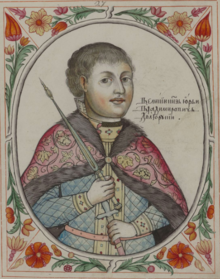This article needs additional citations for verification. (November 2018) |
| Yuri Dolgorukiy | |||||
|---|---|---|---|---|---|
 | |||||
| Prince of Rostov and Suzdal | |||||
| Reign | c. 1108[1] or 1125[2] – 1157[2] | ||||
| Predecessor | First [1] | ||||
| Successor | Andrey Bogolyubsky[3] | ||||
| Grand Prince of Kiev (first) | |||||
| Reign | 1149–1151 | ||||
| Predecessor | Iziaslav II Mstislavich | ||||
| Successor | Iziaslav II Mstislavich | ||||
| Grand Prince of Kiev (second) | |||||
| Reign | 1155–1157 | ||||
| Predecessor | Iziaslav III Davidovich | ||||
| Successor | Iziaslav III Davidovich | ||||
| Born | 1099 | ||||
| Died | 15 May 1157 (aged 57) | ||||
| Burial | |||||
| Spouse |
| ||||
| Issue | |||||
| |||||
| Dynasty |
| ||||
| Father | Vladimir II Monomakh | ||||
Yuri I Vladimirovich (Russian: Юрий Владимирович, romanized: Yury Vladimirovich; Old East Slavic: Гюрги Володи́мирович; c. 1099 – 15 May 1157), commonly known as Yuri Dolgorukiy (Russian: Юрий Долгорукий, romanized: Yury Dolgoruky, lit. 'Long-armed') or the Long Arm, was a Monomakhovichi prince of Rostov and Suzdal, acquiring the name Suzdalia during his reign.[2] Noted for successfully curbing the privileges of the landowning boyar class in Rostov-Suzdal and his ambitious building programme, Yuri transformed this principality into the independent power that would evolve into early modern Muscovy.[4] Yuri Dolgorukiy was the progenitor of the Yurievichi[5] (Russian: Юрьевичи, romanized: Yuryevichi Ukrainian: Юрійовичі, romanized: Yuriiovychi), a branch of the Monomakhovichi.
Yuri spent much of his life in internecine strife with the other Rus' princes for suzerainty over the Kievan Rus, which had been held by his father (Vladimir Monomakh) and his elder brother before him.[citation needed] Although he twice managed to briefly hold Kiev (in September 1149 – April 1151, again in March 1155 – May 1157) and rule as Grand Prince of Kiev, his autocratic rule and perceived foreigner status made him unpopular with the powerful Kievan boyars, leading to his presumed poisoning and the expulsion of his son (later Andrei Bogoliubsky of Vladimir-Suzdal) in 1157.[citation needed] His rule marked the effective end of the Rus' as a unified entity until the Mongol invasions, with powerful provincial territories like Vladimir-Suzdal and Galicia-Volhynia now competing for the throne of Kiev.[citation needed]
- ^ a b Martin 2007, p. 43.
- ^ a b c Martin 2007, p. 110.
- ^ Martin 2007, p. 92.
- ^ Presniakov, Alexander E. (1986) [1918]. The Tsardom of Muscovy. Translated by Price, Robert F. Petrograd: Academic International Press. pp. ix–x. ISBN 9780875690902.
- ^ Martin 2007, pp. 122–124, 127–128, 130, 133, 145, 491.